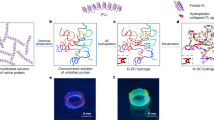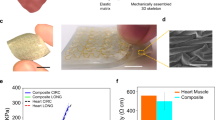Abstract
The passive elasticity of muscle is largely governed by the I-band part of the giant muscle protein titin1,2,3,4, a complex molecular spring composed of a series of individually folded immunoglobulin-like domains as well as largely unstructured unique sequences5. These mechanical elements have distinct mechanical properties, and when combined, they provide the desired passive elastic properties of muscle6,7,8,9,10,11, which are a unique combination of strength, extensibility and resilience. Single-molecule atomic force microscopy (AFM) studies demonstrated that the macroscopic behaviour of titin in intact myofibrils can be reconstituted by combining the mechanical properties of these mechanical elements measured at the single-molecule level8. Here we report artificial elastomeric proteins that mimic the molecular architecture of titin through the combination of well-characterized protein domains GB112 and resilin13. We show that these artificial elastomeric proteins can be photochemically crosslinked and cast into solid biomaterials. These biomaterials behave as rubber-like materials showing high resilience at low strain and as shock-absorber-like materials at high strain by effectively dissipating energy. These properties are comparable to the passive elastic properties of muscles within the physiological range of sarcomere length14 and so these materials represent a new muscle-mimetic biomaterial. The mechanical properties of these biomaterials can be fine-tuned by adjusting the composition of the elastomeric proteins, providing the opportunity to develop biomaterials that are mimetic of different types of muscles. We anticipate that these biomaterials will find applications in tissue engineering15 as scaffold and matrix for artificial muscles.
This is a preview of subscription content, access via your institution
Access options
Subscribe to this journal
Receive 51 print issues and online access
$199.00 per year
only $3.90 per issue
Buy this article
- Purchase on Springer Link
- Instant access to full article PDF
Prices may be subject to local taxes which are calculated during checkout




Similar content being viewed by others
References
Maruyama, K. Connectin/titin, giant elastic protein of muscle. FASEB J. 11, 341–345 (1997)
Wang, K. Titin/connectin and nebulin: giant protein rulers of muscle structure and function. Adv. Biophys. 33, 123–134 (1996)
Tskhovrebova, L. & Trinick, J. Titin: properties and family relationships. Nature Rev. Mol. Cell Biol. 4, 679–689 (2003)
Granzier, H. L. & Irving, T. C. Passive tension in cardiac muscle: contribution of collagen, titin, microtubules, and intermediate filaments. Biophys. J. 68, 1027–1044 (1995)
Labeit, S. & Kolmerer, B. Titins: giant proteins in charge of muscle ultrastructure and elasticity. Science 270, 293–296 (1995)
Rief, M., Gautel, M., Oesterhelt, F., Fernandez, J. M. & Gaub, H. E. Reversible unfolding of individual titin immunoglobulin domains by AFM. Science 276, 1109–1112 (1997)
Linke, W. A. et al. I-band titin in cardiac muscle is a three-element molecular spring and is critical for maintaining thin filament structure. J. Cell Biol. 146, 631–644 (1999)
Li, H. et al. Reverse engineering of the giant muscle protein titin. Nature 418, 998–1002 (2002)
Watanabe, K. et al. Molecular mechanics of cardiac titin's PEVK and N2B spring elements. J. Biol. Chem. 277, 11549–11558 (2002)
Kellermayer, M. S., Smith, S. B., Granzier, H. L. & Bustamante, C. Folding-unfolding transitions in single titin molecules characterized with laser tweezers. Science 276, 1112–1116 (1997)
Tskhovrebova, L., Trinick, J., Sleep, J. A. & Simmons, R. M. Elasticity and unfolding of single molecules of the giant muscle protein titin. Nature 387, 308–312 (1997)
Cao, Y. & Li, H. Polyprotein of GB1 is an ideal artificial elastomeric protein. Nature Mater. 6, 109–114 (2007)
Elvin, C. M. et al. Synthesis and properties of crosslinked recombinant pro-resilin. Nature 437, 999–1002 (2005)
Linke, W. A., Popov, V. I. & Pollack, G. H. Passive and active tension in single cardiac myofibrils. Biophys. J. 67, 782–792 (1994)
Langer, R. & Tirrell, D. A. Designing materials for biology and medicine. Nature 428, 487–492 (2004)
Minajeva, A., Kulke, M., Fernandez, J. M. & Linke, W. A. Unfolding of titin domains explains the viscoelastic behavior of skeletal myofibrils. Biophys. J. 80, 1442–1451 (2001)
Higuchi, H. Viscoelasticity and function of connectin/titin filaments in skinned muscle fibers. Adv. Biophys. 33, 159–171 (1996)
Gosline, J. et al. Elastic proteins: biological roles and mechanical properties. Phil. Trans. R. Soc. Lond. B 357, 121–132 (2002)
Andersen, S. O. The cross-links in resilin identified as dityrosine and trityrosine. Biochim. Biophys. Acta 93, 213–215 (1964)
Nairn, K. M. et al. A synthetic resilin is largely unstructured. Biophys. J. 95, 3358–3365 (2008)
Carrion-Vazquez, M. et al. Mechanical and chemical unfolding of a single protein: a comparison. Proc. Natl Acad. Sci. USA 96, 3694–3699 (1999)
Li, H. et al. Multiple conformations of PEVK proteins detected by single-molecule techniques. Proc. Natl Acad. Sci. USA 98, 10682–10686 (2001)
Fancy, D. A. & Kodadek, T. Chemistry for the analysis of protein-protein interactions: rapid and efficient cross-linking triggered by long wavelength light. Proc. Natl Acad. Sci. USA 96, 6020–6024 (1999)
Urry, D. W. et al. Elastin: a representative ideal protein elastomer. Phil. Trans. R. Soc. Lond. B 357, 169–184 (2002)
Vrhovski, B., Jensen, S. & Weiss, A. S. Coacervation characteristics of recombinant human tropoelastin. Eur. J. Biochem. 250, 92–98 (1997)
Bellingham, C. M. et al. Recombinant human elastin polypeptides self-assemble into biomaterials with elastin-like properties. Biopolymers 70, 445–455 (2003)
Welsh, E. R. & Tirrell, D. A. Engineering the extracellular matrix: a novel approach to polymeric biomaterials. I. Control of the physical properties of artificial protein matrices designed to support adhesion of vascular endothelial cells. Biomacromolecules 1, 23–30 (2000)
Nagapudi, K. et al. Protein-based thermoplastic elastomers. Macromolecules 38, 345–354 (2005)
Bochicchio, B. et al. Synthesis of and structural studies on repeating sequences of abductin. Macromol. Biosci. 5, 502–511 (2005)
Lillie, M. A., Chalmers, G. W. & Gosline, J. M. The effects of heating on the mechanical properties of arterial elastin. Connect. Tissue Res. 31, 23–35 (1994)
Dudek, D. M. et al. Dynamic Mechanical Properties of Synthetic Resilin. in Annual Meeting of the Society for Integrative and Comparative Biology abstr. S7.7, e50 <http://icb.oxfordjournals.org/cgi/reprint/49/suppl_1/e1> (Oxford University Press, 2009)
Helmes, M. et al. Mechanically driven contour-length adjustment in rat cardiac titin's unique N2B sequence: titin is an adjustable spring. Circ. Res. 84, 1339–1352 (1999)
Amin, A. F. M. S., Lion, A., Sekita, S. & Okui, Y. Nonlinear dependence of viscosity in modeling the rate-dependent response of natural and high damping rubbers in compression and shear: experimental identification and numerical verification. Int. J. Plast. 22, 1610–1657 (2006)
Acknowledgements
We thank M. Lillie and R. Shadwick for discussions. This work is supported by the Canadian Institutes of Health Research, the Canada Research Chairs program, the Canada Foundation for Innovation, the Michael Smith Foundation for Health Research, and the Natural Sciences and Engineering Research Council of Canada. H.L. is a Michael Smith Foundation for Health Research Career Investigator.
Author information
Authors and Affiliations
Contributions
H.L. conceived the project. H.L. and J.G. designed the overall experiments. S.L., D.M.D., Y.C., M.M.B. and J.G. designed, performed individual experiments and analysed data. H.L. wrote the manuscript and all authors edited the manuscript.
Corresponding authors
Ethics declarations
Competing interests
The authors declare no competing financial interests.
Supplementary information
Supplementary Information
This file contains Supplementary Information comprising Protein Engineering; Single-Molecule AFM Measurements; Preparation of Biomaterials; Tensile Testing; Monte Carlo simulations on the force-relaxation of GRG5RG4R and Mimicking the passive elasticity of muscle in the full range of sarcomere length; Supplementary Figures S1-S8 with legends and References. (PDF 473 kb)
Rights and permissions
About this article
Cite this article
Lv, S., Dudek, D., Cao, Y. et al. Designed biomaterials to mimic the mechanical properties of muscles. Nature 465, 69–73 (2010). https://doi.org/10.1038/nature09024
Received:
Accepted:
Issue Date:
DOI: https://doi.org/10.1038/nature09024
This article is cited by
-
The effect of adding cobalt ferrite (CoFe3O4) nanoparticles as fillers on rheological and structural behaviour of gum ghatti-cl-poly(NIPAm) hydrogels
Mechanics of Time-Dependent Materials (2024)
-
Cartilage-like protein hydrogels engineered via entanglement
Nature (2023)
-
Bi-enzymatic chemo-mechanical feedback loop for continuous self-sustained actuation of conducting polymers
Nature Communications (2023)
-
Engineering Mechanical Strong Biomaterials Inspired by Structural Building Blocks in Nature
Chemical Research in Chinese Universities (2023)
-
Extensible and self-recoverable proteinaceous materials derived from scallop byssal thread
Nature Communications (2022)
Comments
By submitting a comment you agree to abide by our Terms and Community Guidelines. If you find something abusive or that does not comply with our terms or guidelines please flag it as inappropriate.



